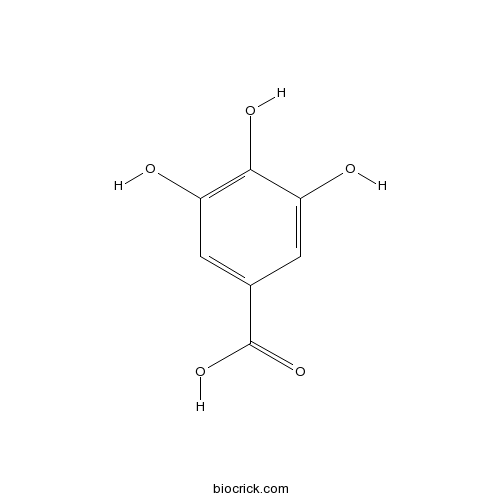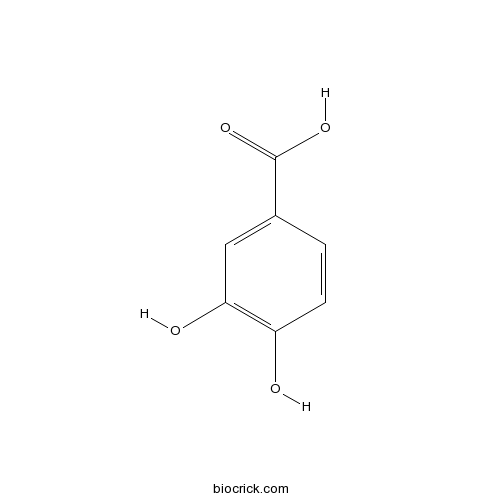Euphorbia thymifolia
Euphorbia thymifolia
1. The products in our compound library are selected from thousands of unique natural products; 2. It has the characteristics of diverse structure, diverse sources and wide coverage of activities; 3. Provide information on the activity of products from major journals, patents and research reports around the world, providing theoretical direction and research basis for further research and screening; 4. Free combination according to the type, source, target and disease of natural product; 5. The compound powder is placed in a covered tube and then discharged into a 10 x 10 cryostat; 6. Transport in ice pack or dry ice pack. Please store it at -20 °C as soon as possible after receiving the product, and use it as soon as possible after opening.
Natural products/compounds from Euphorbia thymifolia
- Cat.No. Product Name CAS Number COA
-
BCN1668
Gallic acid149-91-7
Instructions

-
BCN5658
Apigenin520-36-5
Instructions

-
BCN4537
3,4-Dihydroxybenzoic acid99-50-3
Instructions

Cleome rutidosperma and Euphorbia thymifolia Suppress Inflammatory Response via Upregulation of Phase II Enzymes and Modulation of NF-κB and JNK Activation in LPS-Stimulated BV2 Microglia.[Pubmed: 27618898]
Cleome rutidosperma DC. and Euphorbia thymifolia L. are herbal medicines used in traditional Indian and Chinese medicine to treat various illnesses. Reports document that they have antioxidant and anti-inflammatory activities; nonetheless, the molecular mechanisms involved in their anti-inflammatory actions have not yet been elucidated. The anti-neuroinflammatory activities and underlying mechanisms of ethanol extracts of Cleome rutidosperma (CR) and Euphorbia thymifolia (ET) were studied using lipopolysaccharide (LPS)-stimulated microglial cell line BV2. The morphology changes and production of pro-inflammatory mediators were assayed. Gene expression of inflammatory genes such as inducible nitric oxide synthase (iNOS), cyclooxygenase (COX)-2, interleukin (IL)-1β, and CC chemokine ligand (CCL)-2, as well as phase II enzymes such as heme oxygenase (HO)-1, the modifier subunit of glutamate cysteine ligase (GCLM) and NAD(P)H quinone dehydrogenase 1 (NQO1), were further investigated using reverse transcription quantitative-PCR (RT-Q-PCR) and Western blotting. The effects of CR and ET on mitogen activated protein kinases (MAPKs) and nuclear factor (NF)-κB signaling pathways were examined using Western blotting and specific inhibitors. CR and ET suppressed BV2 activation, down-regulated iNOS and COX-2 expression and inhibited nitric oxide (NO) overproduction without affecting cell viability. They reduced LPS-mediated tumor necrosis factor (TNF) and IL-6 production, attenuated IL-1β and CCL2 expression, but upregulated HO-1, GCLM and NQO1 expression. They also inhibited p65 NF-κB phosphorylation and modulated Jun-N terminal kinase (JNK) activation in BV2 cells. SP600125, the JNK inhibitor, significantly augmented the anti-IL-6 activity of ET. NF-κB inhibitor, Bay 11-7082, enhanced the anti-IL-6 effects of both CR and ET. Znpp, a competitive inhibitor of HO-1, attenuated the anti-NO effects of CR and ET. Our results show that CR and ET exhibit anti-neuroinflammatory activities by inhibiting pro-inflammatory mediator expression and production, upregulating HO-1, GCLM and NQO1, blocking NF-κB and modulating JNK signaling pathways. They may offer therapeutic potential for suppressing overactivated microglia and alleviating neurodegeneration.
An in silico study on antidiabetic activity of bioactive compounds in Euphorbia thymifolia Linn.[Pubmed: 27588252]
Herbal medicines have become strongly preferred treatment to reduce the negative impacts of diabetes mellitus (DM) and its severe complications due to lesser side effects and low cost. Recently, strong anti-hyperglycemic effect of Euphorbia thymifolia Linn. (E. thymifolia) on mice models has reported but the action mechanism of its bioactive compounds has remained unknown. This study aimed to evaluate molecular interactions existing between various bioactive compounds in E. thymifolia and targeted proteins related to Type 2 DM. This process involved the molecular docking of 3D structures of those substances into 4 targeted proteins: 11-β hydroxysteroid dehydrogenase type 1, glutamine: fructose-6-phosphate amidotransferase, protein-tyrosine phosphatase 1B and mono-ADP-ribosyltransferase sirtuin-6. In the next step, LigandScout was applied to evaluate the bonds formed between 20 ligands and the binding sites of each targeted proteins. The results identified seven bioactive compounds with high binding affinity (<-8.0 kcal/mol) to all 4 targeted proteins including β-amyrine, taraxerol, 1-O-galloyl-β-d-glucose, corilagin, cosmosiin, quercetin-3-galactoside and quercitrin. The pharmacophore features were also explained in 2D figures which indicated hydrophobic interactions, hydrogen bond acceptors and hydrogen bond donors forming between carbonyl oxygen molecules of those ligands and active site residues of 4 targeted protein.Graphical abstract Euphorbia thymifolia Linn. is a small prostrate herbaceous annual weed that can positively impact on reducing hyperglycemic effect. In order to clearly understand about molecular level of the its bioactive compounds, in silico approach is performed.
Green synthesis of Pd nanoparticles mediated by Euphorbia thymifolia L. leaf extract: Catalytic activity for cyanation of aryl iodides under ligand-free conditions.[Pubmed: 26890384]
Pd nanoparticles (NPs) were synthesized by using aqueous extract of leaves of Euphorbia thymifolia L., a non-toxic ecofriendly material. The catalytic activity of the Pd NPs was investigated in the cyanation of aryl iodides using K4Fe(CN)6 as the cyanating agent under ligand-free conditions. The nitriles were obtained in good to excellent yield and the catalyst can be recovered and reused for five times without significant loss of catalytic activity.
A review on phyto-pharmacological potentials of Euphorbia thymifolia L.[Pubmed: 24501446]
Euphorbia thymifolia L. (Euphorbiaceae) is a small branched, hispidly pubescent, prostate annual herb, commonly known as laghududhika or choti-dudhi. The leaves, seeds and fresh juice of whole plant are used in worm infections, as stimulant, astringent. It is also used in bowel complaints and in many more diseases therapeutically. The present work is an extensive review of published literature concerning phytochemical and pharmacological potential of E. thymifolia. Data was searched and designed using various review modalities manually and using electronic search engines with reference to all aspects of E. thymifolia and was arranged chronologically. Complete information of the plant has been collected from the various books and journals since the last 32 years, internet databases, etc., were searched. Compiled data reflects the safety and therapeutic efficacy of the plant. This will be helpful for researchers to focus on the priority areas of research yet to be explored and in scientific use of the plant for its wide variety of traditional therapeutic claims and also as to find out new chemical entities responsible for its claimed traditional activities.
Thymofolinoates A and B, new cinnamic acid derivatives from Euphorbia thymifolia.[Pubmed: 23157007]
Two new cinnamic acid derivatives, thymofolinoates A (1) and B (2) have been isolated from the chloroform soluble fraction of Euphorbia thymifolia and their structures assigned from 1H and 13C NMR spectra, DEPT and by 2 D COSY, HMQCand H MBC experiments. In addition, p-hydroxy cinnamic acid(3), 5-hydroxy-6,7,8,4'-tetramethoxy flavone (4), and 5-hydroxy-3',4',6,7,8-pentamethoxy flavone (5) have also been isolated for the first time from this species.
Antihyperglycemic and antinociceptive activities of methanolic extract of Euphorbia thymifolia L. whole plants.[Pubmed: 22313890]
To study the antihyperglycemic and antinociceptive activities of methanolic extract of the whole plant of Euphorbia thymifolia L., a plant used in folk medicine of Bangladesh for treatment of diabetes and pain.
Isolation and identification of mosquito larvicidal compound from Abutilon indicum (Linn.) Sweet.[Pubmed: 18176816]
Larvicidal activity of crude hexane, ethyl acetate, petroleum ether, acetone and methanol extracts of five medicinal plants, Abutilon indicum, Aegle marmelos, Euphorbia thymifolia, Jatropha gossypifolia and Solanum torvum were assayed for their toxicity against the early fourth-instar larvae of Culex quinquefasciatus. The larval mortality was observed after 24 h exposure. All extracts showed moderate larvicidal effects; however, the highest larval mortality was found in petroleum ether extract of A. indicum. In the present study, bioassay-guided fractionation of A. indicum led to the separation and identification of a beta-sitosterol as a potential new mosquito larvicidal compound with LC50 value of 11.49, 3.58 and 26.67 ppm against Aedes aegypti L, Anopheles stephensi Liston and C. quinquefasciatus Say (Diptera: Culicidae), respectively. 1H NMR, 13C NMR and mass spectral data confirmed the identification of the active compound. beta-sitosterol has been recognized as the active ingredient of many medicinal plant extracts. All the crude extracts when screened for their larvicidal activities indicated toxicity against the larvae of C. quinquefasciatus. This article reports the isolation and identification of the beta-sitosterol as well as bioassay data for the crude extracts. There are no reports of beta-sitosterol in the genus A. indicum, and their larvicidal activities are being evaluated for the first time. Results of this study show that the petroleum ether extract of A. indicum may be considered as a potent source and beta-sitosterol as a new natural mosquito larvicidal agent.


